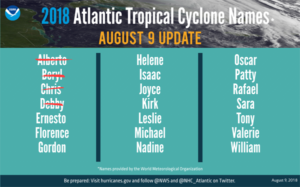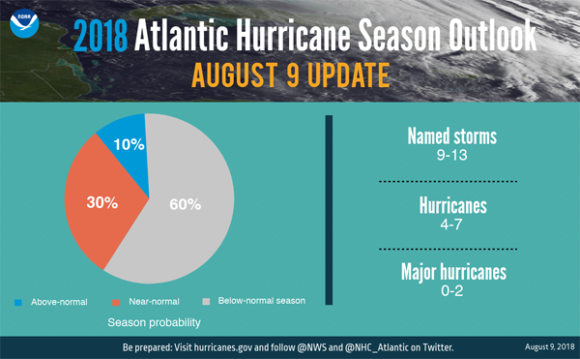Conditions in the ocean and the atmosphere are producing a less active Atlantic hurricane season than initially predicted in May.
Forecasters with NOAA’s Climate Prediction Center said the likelihood of a below-normal Atlantic hurricane season is now 60 percent, up from 25 percent in May.
The likelihood of a near-normal season is now at 30 percent, and the chance of an above-normal season has dropped from 35 percent to 10 percent.
For the entire season, which ends Nov. 30, NOAA predicts a total of 9-13 named storms (winds of 39 mph or greater) of which 4-7 will become hurricanes (winds of 74 mph or greater), including 0-2 major hurricanes (winds of 111 mph or greater).
Even with the lower forecast, NOAA warned there could still be activity as the season enters its peak month.
“There are still more storms to come – the hurricane season is far from being over. We urge continued preparedness and vigilance,” said Gerry Bell, Ph.D., lead seasonal hurricane forecaster at NOAA’s Climate Prediction Center.
So far, the season has seen four named storms, including two hurricanes. An average six-month hurricane season produces 12 named storms, of which six become hurricanes, including three major hurricanes.
 This current outlook is for overall seasonal activity and is not a landfall forecast. Landfalls are largely determined by short-term weather patterns, which are only predictable within about one week of a storm potentially reaching a coastline.
This current outlook is for overall seasonal activity and is not a landfall forecast. Landfalls are largely determined by short-term weather patterns, which are only predictable within about one week of a storm potentially reaching a coastline.
To produce the seasonal update, forecasters take several factors into account. El Nino is now much more likely to develop with enough strength to suppress storm development during the latter part of the season. NOAA’s Climate Prediction Center has updated its forecast to a nearly 70 percent likelihood of El Nino during the hurricane season.
Additionally, sea surface temperatures across the tropical Atlantic Ocean and Caribbean Sea have remained much cooler than average. A combination of stronger wind shear, drier air and increased stability of the atmosphere in the region where storms typically develop will further suppress hurricanes. Storm activity to-date and the most recent model predictions also contribute to this update.
NOAA urged coastal residents to have their hurricane preparedness plans in place and to monitor the latest forecasts as the hurricane season continues.
Topics Catastrophe Natural Disasters Windstorm Hurricane Aerospace
Was this article valuable?
Here are more articles you may enjoy.



 Grandson Not Covered Under Grandma’s Home Insurance
Grandson Not Covered Under Grandma’s Home Insurance  New York State Police Report 37-Vehicle Pileup on I-81 Near Syracuse
New York State Police Report 37-Vehicle Pileup on I-81 Near Syracuse  SIAA Announces Strategic Partnership With Progressive
SIAA Announces Strategic Partnership With Progressive  Allstate Can Proceed With Recovery in Texas RICO Case: Fifth Circuit
Allstate Can Proceed With Recovery in Texas RICO Case: Fifth Circuit 

